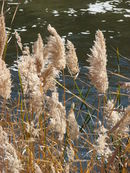Ecology and Evolution (2018) 8, 2440-2452
From Pestinfo-Wiki
 | Selected publication you are invited to contribute to the discussion section (above tab) |
Living in two worlds: Evolutionary mechanisms act differently in the native and introduced ranges of an invasive plant
Ecology and Evolution 8 (5), 2440-2452
Abstract: Identifying the factors that influence spatial genetic structure among populations can provide insights into the evolution of invasive plants. In this study, we used the common reed (Phragmites australis), a grass native in Europe and invading North America, to examine the relative importance of geographic, environmental (represented by climate here), and human effects on population genetic structure and its changes during invasion. We collected samples of P. australis from both the invaded North American and native European ranges and used molecular markers to investigate the population genetic structure within and between ranges. We used path analysis to identify the contributions of each of the three factors—geographic, environmental, and human-related—to the formation of spatial genetic patterns. Genetic differentiation was observed between the introduced and native populations, and their genetic structure in the native and introduced ranges was different. There were strong effects of geography and environment on the genetic structure of populations in the native range, but the human-related factors manifested through colonization of anthropogenic habitats in the introduced range counteracted the effects of environment. The between-range genetic differences among populations were mainly explained by the heterogeneous environment between the ranges, with the coefficient 2.6 times higher for the environment than that explained by the geographic distance. Human activities were the primary contributor to the genetic structure of the introduced populations. The significant environmental divergence between ranges and the strong contribution of human activities to the genetic structure in the introduced range suggest that invasive populations of P. australis have evolved to adapt to a different climate and to human-made habitats in North America.
(The abstract is excluded from the Creative Commons licence and has been copied with permission by the publisher.)
Full text of article
Database assignments for author(s): Petr Pysek, Laura A. Meyerson
Research topic(s) for pests/diseases/weeds:
environment - cropping system/rotation
Pest and/or beneficial records:
| Beneficial | Pest/Disease/Weed | Crop/Product | Country | Quarant. |
|---|---|---|---|---|
| Phragmites australis (weed) | France | |||
| Phragmites australis (weed) | Italy | |||
| Phragmites australis (weed) | Spain (continental) | |||
| Phragmites australis (weed) | United Kingdom | |||
| Phragmites australis (weed) | U.S.A. (NW) | |||
| Phragmites australis (weed) | U.S.A. (mid N) | |||
| Phragmites australis (weed) | U.S.A. (NE) |